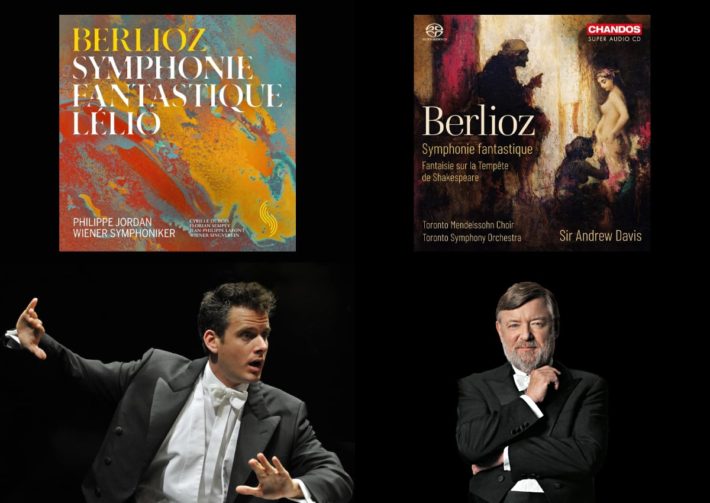Right off the bat, it can be declared these are both very good versions of the Symphonie Fantastique. Comparing the two is intriguing as well as difficult, both because of the generally high level of execution and because of the difference in approaches between the two.


Focusing on Jordan, one is immediately impressed by the beauty of tone the Vienna Symphoniker produces, an orchestra unfortunate to stand in the shadow of the same city’s Philharmoniker, but with a tradition and performance quality not far off from the more renowned ensemble. The opening introduction, a depiction of an artist infatuation, is nicely done, a controlled longing with sufficient warmth, very little vibrato and dreamy phrasing. Jordan takes his time here, crescendos accurately projected without losing a grip of the musical line (the main line of the strings with woodwind accompaniment is particularly lovely from 2:18). The transition to the “passions” segment is another expertly executed affair.
The waltz of “Un Bal” has a charm to it that sounds completely natural, not without a hint of Strauss Junior, charming slides over the strings’ necks, sharp harps and all. The slow movement is a reserved, quiet performance that tends to the static. Nothing wrong with the individual soloists taking part (clarinet, cor anglais and flute especially), and at 3:30 the chords are nicely balanced, but the pizzicatos are almost inaudible and there is something almost too beautified in the interpretation, making it lose the momentum of this impressive performance. The same can be said for the following two movements – the playing is in the highest order, but the tension that started in the first two movements never really takes wind again. The results are enjoyable for sure, but feels tamed next to Davis’ version.
Berlioz From Toronto
Turning to Davis, we have another orchestra which stands in the shadow of the great Orchestre Symphonique de Montréal. The Toronto Symphony orchestra has a distinct sharper and more opened sound than the Montréal ensemble, a more outwardly bravura in the climaxes and crisp attacks when called for. But here the opening of the Symphony is more hesitant than in Jordan’s version, the players feel somewhat unsure in the rests of the opening. Things in general take a bit more time to get going. But once we get to the “passions”, the playing is energetic and affectionately romantic. There is less attention to every orchestral detail, but the enthusiastic performance more than compensates. The basses, as an example, are much more effective here than in Jordan’s version; Listen how the group interrupts the upper line from 5:00 onwards.
The waltz, on the other hand, is going a bit too far with the glissandi, sounding forced and unnatural, and the harps are not brought to the fore as in Jordan’s charming rendition. With the slow movement, it’s Davis that has the edge. The solo contributions is not as distinctive as in the Vienna version (though expertly done), but the overall result is more persuasive and the movement never lags. Curiously, this is despite the fact it is objectively half a minute longer in time than in Jordan’s version. This may have to do with the strings, which show more involvement and are unabashedly sentimental.
The two final movements, where Jordan is sufficient and skillful but lacks in extra tension, is almost the opposite here – a performance full of vigor, less glowingly voiced but less reserved and wilder, maybe more inlined with the context of this programmatic piece.
Returning to Life
Jordan’s second CD includes a rarely heard rendition of the Symphonie Fantastique’s followup work, “Lélio, ou Le retour à la vie“, the piece which finally got the attention of his muse, actress Harriett Smithson. It is brought in full, including the spoken texts, with baritone Jean-Philippe Lafont as the narrator, waking up from the opium-induced hallucinations depicted in the Symphonie Fantastique. Tenor Cyrille Dubois excels in “The Fisherman” (track 2) as well in the rest of this piece, his voice superbly catches the lyrical element of the music. The choir segments are sung by the Wiener Singverein. Overall, this second CD is, in many aspects, more arresting than the fine performance of the Symphonie Fantastique, if only because of its rarity.
Davis is more modest with the fill-ups, keeping all music on a single disc. His addition is the “Fantaisie sur la Tempête de Shakespeare”, which used as the closing chapters for “Lélio”. The same differences of approach are notable here as well; Less acute awareness of orchestra details, but the choir (Toronto Mendelssohn Choir) is more affectionate and the orchestra giving warmer support.
To sum up, both performances can use a bit more cohesion, but are also qn enjoyable listen to the endlessly fascinating Symphonie Fantastique. Davis is offered in a single hybrid SACD, while Jordan is offered in a double CD, priced accordingly but including a welcomed addition to the small “Lélio” catalog. Both albums are superbly recorded, but Jordan has the benefit of using the Goldener Saal of the Musikverein Wien, with a wider acoustic.
Images: ©️ JF Leclercq and ©️ Dari Acosta
Berlioz – Symphonie Fantastique, Op. 14, “Lélio ou Le retour à la vie”, Op. 14b.
Wiener Symphoniker
Cyrille Dubois – Tenor
Florian Sempey – Baritone
Ingrid Marsoner – Piano
Jean-Philippe Lafont – Narrator
Wiener Singverein
Philippe Jordan – Conductor
Wiener Symphoniker label, CD WS020
Berlioz – Symphonie Fantastique, Op. 14, “Fantaisie sur la Tempête de Shakespeare”, Op. 14 H52
Toronto Symphony Orchestra
Toronto Mendelssohn Choir
Sir Andrew Davis – Conductor





















